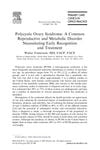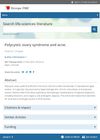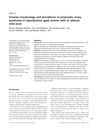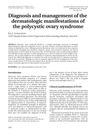Update on Polycystic Ovary Syndrome
October 2016
in “
Journal of the Dermatology Nurses’ Association
”

TLDR Polycystic Ovary Syndrome (PCOS) affects 6%-15% of women of reproductive age, causing symptoms like acne and hair loss, and increasing the risk of type 2 diabetes and heart disease; it's managed through diet, exercise, and medications like Metformin and hormonal contraceptives.
The document from 2016 discussed Polycystic Ovary Syndrome (PCOS), an endocrine disorder affecting 6%-15% of reproductive-aged women, characterized by symptoms like acne, hirsutism, and androgenic alopecia. It emphasized early diagnosis and treatment to prevent comorbidities like type 2 diabetes and cardiovascular disease. Even normal-weight women with PCOS had a higher risk for developing type 2 diabetes than overweight women without PCOS. The document provided guidance on PCOS assessment, diagnosis, and management, highlighting the Rotterdam criteria for diagnosis. It also discussed the economic burden of PCOS, estimated at 4.37 billion dollars in 2005. Management aimed at decreasing symptoms, promoting menstrual regularity, reducing risk for type 2 diabetes and cardiovascular disease, promoting quality of life, and assisting women who desire to conceive. Lifestyle modification with diet and exercise was the first-line treatment, with pharmacological management including Metformin and combined Hormonal Contraceptives. The diuretic spironolactone was an effective add-on treatment for hirsutism, acne, and alopecia due to its antiandrogen effects.



